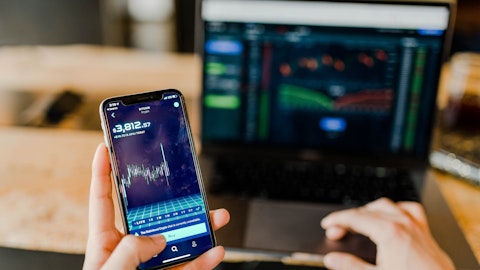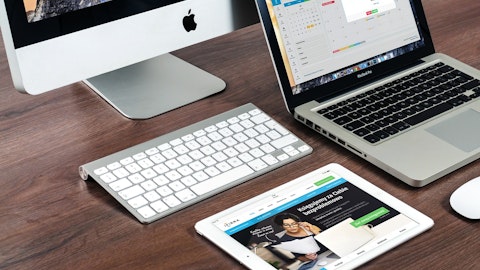Samik Chatterjee: Okay. And maybe if I can just follow up and this is more of a macro question. I don’t know if Luca, you or Tim want to take this, but obviously the macro is not sort of helpful at this point. But what you’re sort of implying in terms of your guide is momentum for your products remains pretty stable. You’re actually guiding to a modest uptick FX for the overall business. I mean, what are you seeing in terms of customer sort of spending trends? And overall, does the consumer sort of continue to deteriorate in terms of spending patterns? And is your sort of momentum here just a function of share gains? How should we think about sort of where the consumer is versus what your products are doing independent of that?
Luca Maestri: Part of Samik is what Tim was talking about. We’re having great momentum in emerging markets, and those are markets where our share is low, gives us a great opportunity to grow over time. It also helps us with the growth of the installed base, because you can imagine that in places where our market share is low, we tend to add a lot of switchers people that are new to the Apple ecosystem. That increases the install base. And over the longer term, it obviously improves our ability to monetize on services as well.
Operator: Our next question is from Amit Daryanani of Evercore.
Amit Daryanani: I have to as well. I guess, first off on gross margins for the June quarter. They seem to be holding up fairly well, especially given the fact that sales are going down on a sequential basis. So, Luca, I’m wondering if you can just touch on what’s driving the strength in gross margin sequentially. It’s offsetting the lack of leverage, if you may. And then I also noticed that the range of your gross margin guide is 50 basis points, it’s typically 100. What does that entail? What does that mean?
Luca Maestri: So you’re right. I mean we are guiding to a fairly stable level of gross margins at a very high level. We’re very happy with the gross margins that we’re having this cycle. For the first time in several quarters, foreign exchange, we expect foreign exchange to be flat on a sequential basis at the gross margin level. Unfortunately, it’s still a headwind at the revenue level, but at gross margin level, sequentially, we expect foreign exchange not to be a factor. And so the seasonal loss of leverage that you’re referring to, we expect to be offset by cost savings. And so that should give us that level of margins. As you know, you were asking about the 50 basis points. We have guided to 50 basis points of a range before as well, this year in particular, because of the 14th week during the December quarter, we’re a bit late in the calendar year, right. And so we have a bit more visibility around margins for the June quarter.
Amit Daryanani: Got it. That’s helpful. And then I guess, Tim, if I just go back to the India discussion a bit, perhaps you could just contrast what you’re seeing in India at today versus what you saw in China maybe a decade or so ago. Is that a reasonable ramp to think India would have, or could it be different from the lessons you’ve seen in China?
Tim Cook: I think each country is different and has their own journey, so I hesitate to compare too much. But what I do see in India is a lot of people entering the middle class, and I’m hopeful that we can convince some number of them to buy an iPhone and we’ll see how that works out. But right now, it’s working out well.
Operator: Our next question is from Krish Sankar of TD Cowen.
Krish Sankar: Hi, thanks for taking my question. The first question I had is for Tim. Tim, you’re primarily been a consumer centric company, but it seems like the line is blurring with the iPhone, iPad, the hardware products being used for corporate applications. So is there a way to segment how much of your revenues today are coming from enterprise versus consumer? And does the slower corporate IT spend impact your outlook for iPhone, iPad, Mac, et cetera, and then I have a follow up.
Tim Cook: Internally, we have our estimates for how much is enterprise versus consumer. And the enterprise business is growing. We have been focusing a lot on BYOD programs and there’s more and more companies that are leaning into those and given employees the ability to select which is plays to our benefit, I believe, because I think a lot of people want to use a Mac at work or an iPad at work. And so but we’re certainly primarily a consumer company in terms of our revenues, obviously.
Krish Sankar: Got it, Tim. Thanks for that. And then just as a follow up, obviously a lot of questions on the India retail opening. I’m just kind of curious. You also mentioned that you hope to convert a lot of folks into iPhone there. Where do you think the biggest opportunity? Is it like primarily a hardware business like the iPhone, iPad wearables, et cetera? Or do you think there is a service opportunity in India longer term too? Thank you very much.
Tim Cook: I think there’s an opportunity across the board, including in services. Obviously, the ARPUs are lower in India for whether you’re talking about TV and movie streaming or music, the ARPUs are much lower than other regions. But if you look at it over a long arc of time, I think there’s a good opportunity across the board.
Operator: Our next question is from Aaron Rakers of Wells Fargo.
Aaron Rakers: Yes, thanks for taking the questions. I guess my first question is that I want to go back to kind of the geographical dynamics. I’m curious, as we all think about the reopening attributes of China, just how you would characterize the shaping of demand you saw through the course of this last quarter and kind of how you’re thinking about the impact of that reopening playing out over the next couple of quarters.
Tim Cook: If you look at China, our revenue came in at negative three for the quarter year-over-year, but we actually grew on a constant currency basis, and we also accelerate rated as compared to the December quarter, which, as you know, had 14 weeks in it and was a negative seven on a reported basis. And so we were pleased with how we did and with the acceleration that we saw with the reopening, and we’ll see how we do this quarter. But if you look at the top selling smartphones in urban China, based on a survey from Kantar, we have four out of the top five. And I think in all of the third party data I’ve seen on the market itself, in the smartphone space, we believe we gained share during Q2. So we feel good about it. Also, China has a lot of very good metrics in terms of new buyers.
For example, on the Mac, about six out of ten customers are buying the Mac for the first time. Same thing on iPad. If you look over at the watch, it’s more than three out of four customers are buying the watch for the first time. And so the buyer metrics, if you will, are very, very good. And our services business hit an all-time record in China during the quarter.
Aaron Rakers: Very helpful, Tim. As a quick follow up, I want to go back to Amit’s question on gross margin. You talked about FX, the lessening impact there. I’m just curious when you look at your gross margin, obviously got mixed attributes, kind of potentially continuing to drive that higher. But I’m curious on the current environment, how you would characterize the component pricing dynamics and what you’re thinking about in this current quarter’s Guidance.
Luca Maestri: The environment on the component side is favorable. We’ve seen component prices decline during the March quarter, and we expect the same during the June quarter.
Operator: Our next is from Sydney Ho of Deutsche Bank.
Sydney Ho: Great. Thanks for taking my question. I was hoping you can talk about the linearity of the March quarter and perhaps the first four and a half weeks of the current quarter. It looks like things are slowing down quite a bit elsewhere, but if my math is right, your fiscal third quarter guidance implied product revenue will be a little bit lower than seasonal average on a sequential basis, any color would be helpful. Thanks.
Luca Maestri: We said that we expect our performance during the June quarter at the revenue level to be similar to the one that we just reported for the March quarter. Keep in mind, we always have differences in the launch timing across our products, and also that especially over the last few years, we’ve seen a certain amount of supply disruptions. Sometimes it was COVID related, sometimes it was related to specific component shortages. Just to remind you, in the June quarter a year ago, at the full quarter impact of the launch for both of the iPhone SE and the iPad Air, which leads to a more difficult compare. So I think it’s important to keep those things in mind.
Sydney Ho: Okay, that’s helpful. Maybe a quick follow up. You talk about Apple Pay Later. How has the feedback been so far? And how do you expect the adoption of that service over the next few quarters? Thank you.





